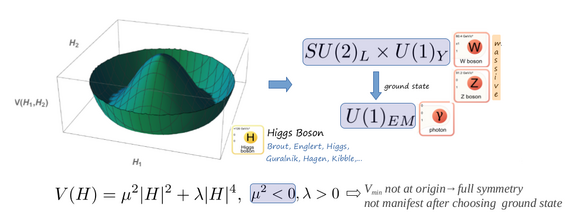Understanding Electroweak Symmetry Breaking: The Higgs Potential
In the SM, EW symmetry is broken down to U(1)EM of electromagnetism (leaving the photon massless, but generating mw ~ mz ~ MEW) 'by hand' via adding a SU(2)L doublet scalar H, the Higgs field, with a 'Mexican-hat' potential V(H), assuming µ2 < 0. Expanding around the resulting ground state (Vmin) at <IHI> ~ MEW> 0, EW symmetry is hidden, inducing masses while the theory stays sensible at high energies. The concrete properties of the Higgs potential lie at the heart of many unresolved puzzles of nature, such as the hierarchy problem, the nature of the EW phase transition (relevant for the baryon abundance), and the stability of our vacuum. It is thus of utmost importance to extract V(H), which is a focus of NEWFO. In fact, we have not yet tested experimentally the common assumption that a negative sign mass term triggers EW symmetry breaking [1]. This could be done by extracting the Higgs self-couplings (see Cosmology and SMEFT).
[1] F. Goertz, PRD 94 (2016), 015013
